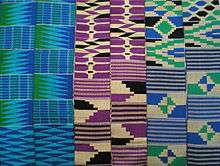Stripweave
Stripweave is a textile technique in which large numbers of thin strips of cloth are sewn together to produce a finished fabric. Most stripweave is produced in West Africa from handwoven fabric, of which the example best known internationally is the kente cloth of Ghana.[1]

Production of kente cloth, a type of stripweave, on a narrow double heddle loom.
The earliest evidence of this traditional technique dates to the eleventh century among the Tellem people of Mali.[2]
Materials
Cotton, silk, and rayon are the usual fibers for stripweave garment production.[1] Traditionally these were hand spun, although machine spun synthetics are coming into increasing use.[2] Wool is also in use for stripweave blankets by the Fulani people in Mali.[1][2]
gollark: Technically, codes are not actually against the rules, but the whole thing is crazy and broken.
gollark: It did make TJ09 claim that he would fix the rules, at least!
gollark: Don't worry, if you get banned for some minor detail then the ensuing forum salt will probably stop it happening.
gollark: Unless there's a trade for a thing you want quite a lot, in which case maybe do offer on it.
gollark: Prizes breed prizes more often than they *should* based on their rarity.
References
- John Gillow and Bryan Sentance (1999). World Textiles: A Visual Guide to Traditional Techniques. Thames & Hudson. p. 92.
- John Gillow (2003). African Textiles. Chronicle Books. p. 29. ISBN 978-0-8118-4166-5. Retrieved 2009-02-14.
This article is issued from Wikipedia. The text is licensed under Creative Commons - Attribution - Sharealike. Additional terms may apply for the media files.
